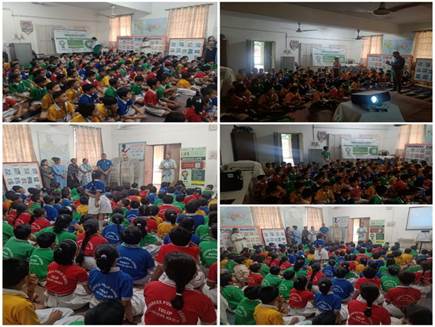Introduction to Compressed Breathing Air
Introduction to Compressed Breathing Air
Introduction to Compressed Breathing Air
Compressed air has many applications, including its use in Self-Contained Breathing Apparatus (SCBA). This document provides some practical information about the tests needed to guarantee SCBA Breathing Air Quality as described in the following:
Air Composition
Common Air Contamination Sources
Carbon Monoxide (CO) Contamination
Carbon Dioxide (CO2) Contamination
Oxygen (O2) Level Control
Total Hydrocarbon Content (THC as methane)
Oil (Consensable Mist/Vapor) and Particulate Matter
Water Vapor (H2O), Content, and Dew Point
Odor Evaluation
Air Composition
Clean, natural air is an odorless, colorless gas mixture. Excluding water vapor (H2O) levels, which vary greatly, three major elements make up about 99.97% of dry air: nitrogen (N2) at 78.09%, oxygen (O2) at 20.95% and argon (Ar) at 0.93%. An important minor component of natural air is carbon dioxide (CO2) at 0.03% (300 ppm). Trace gases in clean, natural air include: methane (CH4) at 0.0002% (2 ppm) and less than 0.0001% (1 ppm) of hydrogen (H2), nitrous oxide (N2O), ozone (O3) and some noble gases. Synthetic air is also used in SCBA applications. This type of air is produced by blending N2 and O2 gas in the proper proportions.
The importance of clean breathing air to sustaining life and maintaining good health is well known. The dangers associated with breathing contaminated air are also well known and especially critical when using SCBA tanks in emergency situations. To ensure SCBA air quality, NFPA 1404 (Sec. 7-1.1) requires a minimum CGA G-7.1 Grade D air quality, at least a 3-month air sampling schedule and a test record maintenance program. Many fire and rescue department programs have opted to use CGA G-7.1 Grade E (the minimum SCUBA grade for diving to 130 ft.) as their minimum SCBA air standard.
Industrial emissions, vehicle exhaust, combustion heating activities and local environmental conditions can seriously degrade the quality of intake air used during compression. Compressor equipment, malfunctions and poor maintenance or operational practices can also introduce contaminants into SCBA air tanks.
CO (a colorless, odorless gas) ranks as the most dangerous compressed air contaminant. Headaches, dizziness, unconsciousness and death can result from exposure to elevated CO levels. High-pressure compressors are often equipped with a catalyst which converts CO into much less toxic CO2. Both CGA G-7.1 Grades D and E (the most widely recognized SCBA air quality grades) list a 10 ppm maximum CO content. If a good air supply and a properly functioning, efficient compressor are in use, CO levels will be less than 1 ppm. Detectable CO levels above 1 - 2.5 ppm are abnormal and require further investigation.
Normal CO2 levels in outdoor air (i.e. 200 - 400 ppm) or indoor air (i.e. 500 - 2,500 ppm) are not considered hazardous. However, compressed air with CO2 levels that are within the "indoor air range" can create problems in SCBA applications. Some compressors are equipped with filters to reduce CO2 levels. CGA G-7.1 lists a 1,000 ppm maximum for Grade D and a 500 ppm maximum for Grade E air. High CO2 levels in SCBA tanks can produce many of the same symptoms as CO poisoning (see above). In addition, high CO2 levels increase breathing rates, which shorten SCBA usage time. One of the most common causes of SCBA air quality failures is excessive CO2 content.
The O2 level in compressed air derived from natural or synthetic air should fall within a narrow % range. CGA G-7.1 lists an allowable 19.5 - 23.5% range for Grade D and a tighter 20 - 22% range for Grade E air. Most compressed natural air samples will have test values of 21% ± 0.5. Synthetic air samples tend to have a slightly wider, but acceptable, O2 range.
Several thousand types of organic gases and vapors are potentially present in air. Volatile organic contaminants can be man-made (e.g. gasoline vapor, exhaust fumes, cleaning solvents, lube oil vapor) or the result of biogenic activities (e.g. marsh gas, mold, mildew). Many organic vapors are hazardous and/or have irritating odors. A common feature of these volatile organic materials is that they contain 1 or more hydrogen (H) + carbon (C) atom. Since it is impractical to measure each type of organic contaminant present, they are measured as a group and described as a "Total Hydrocarbon Content" (TH).
The instrument used to measure TH responds to the total amount of H+C containing molecules present. Since methane gas standards are used to calibrate this instrument, TH results are reported in "ppm v/v as methane" units. CGA G-7.1 does not list a TH limit for Grade D air, but sets a 25 ppm TH maximum for Grade E air. Clean, natural air has a TH value of about 2 ppm due to the normal presence of methane at 2 ppm. Compressed synthetic air can have TH values of less than 1 ppm. TH Values for compressed air that are greater than about 5 ppm are abnormal and require further investigation. High-pressure compressors are usually equipped with odor filters (e.g. activated charcoal filters) that remove many organic vapors. A high TH value could indicate, for example, charcoal filter saturation and the presence of lube oil degradation mist/vapors.
Air compressors, including non-lubricated models, utilize some type of lubricating fluid. Many compressors contain either mineral or synthetic lubricants (e.g. oil). Even with particle, oil and odor filters, it is still possible for oil (e.g. aerosol mist or vapor) or fine particulates (e.g. dust, dirt, powders, wear particles, pollen, spores) to contaminate SCBA air if a mechanical malfunction occurs or there has been poor maintenance. The proper sampling of compressed air for oil mist/vapor and particulates is difficult because these contaminants are not evenly distributed in the air stream and can condense on tank walls or within regulators. Re-introduction of oil mist/vapor and particulates into the air stream can occur under the right conditions.
Sampling procedures involve connecting a filter assembly to the compressor outlet, SCBA tank or a filled sample cylinder and passing a known amount of air through the pre-weighed filter. The total weight of oil plus particulates trapped is measured in a laboratory. Both CGA G-7.1 Grades D and E list a 5 mg/m3 (0.005 mg/L = 5 ppm w/v) maximum for oil mist/vapor at Normal Temperature and Pressure (NTP = 20° [68°F] and 1 atm [14.7 psia = 101 kPa abs = 760 mm Hg]). Detectable oil levels above 0.1 - 0.3 mg/m3 are abnormal and require further investigation.
The dew point is the temperature at which H2O vapor will start to condense from air. This value depends upon the air's H2O vapor content and pressure. The H2O vapor content of intake air ranges from saturated to very dry. Saturation levels are in the low % range. For example, at 20°C (68°F) air can hold 2.3% H2O vapor (23,100 ppm v/v = 34 mg/L). At 40°C (104°F) this value is 6.8% (68,400 ppm v/v = 51 mg/L). The amount of H2O vapor that gets into SCBA air depends on the intake air level and filter efficiency. SCBA air is required to be dry enough to prevent malfunctions (e.g. air flow blockage) due to internal condensation or icing caused by expansion cooling past regulators. High H2O levels can also inhibit catalysts that convert CO into CO2. CGA G-7.1 does not list an H2O limit for Grade D or E air. However, SCBA air must either have a maximum H2O content of 63 ppm (0.05 mg/l), which corresponds to a -50°F dew point, or an H2O vapor maximum (ppm) resulting in a dew point that is 10°F lower than the coldest temperature expected for SCBA use. Therefore, H2O vapor limits for SCBA air are essentially dependent on the geographic region. CGA dew point limits are not pressure values but refer to "dew point over ice at 1 atm."
Clean air is odorless. Many air compressors have filters to remove odors. Both CGA G-7.1 Grades D and E require that "no pronounced odor" be present in compressed air. Since the sensory response of the human nose is highly variable and extremely sensitive to certain odors, evaluation of "odor" is highly subjective. If there is a slight odor, this may be abnormal.










































.JPG)



